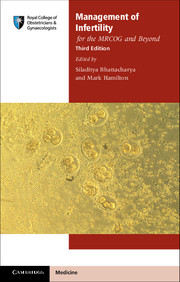Book contents
- Frontmatter
- Contents
- About the authors
- Preface
- Acknowledgements
- Abbreviations
- 1 Epidemiology and initial assessment
- 2 Male factor infertility
- 3 Ovulatory disorders
- 4 Tubal infertility
- 5 Endometriosis-related infertility
- 6 Uterine factors in infertility
- 7 Unexplained infertility
- 8 Assisted reproduction – preparation and work-up of couples
- 9 Assisted reproduction – clinical and laboratory procedures
- Index
7 - Unexplained infertility
Published online by Cambridge University Press: 05 June 2014
- Frontmatter
- Contents
- About the authors
- Preface
- Acknowledgements
- Abbreviations
- 1 Epidemiology and initial assessment
- 2 Male factor infertility
- 3 Ovulatory disorders
- 4 Tubal infertility
- 5 Endometriosis-related infertility
- 6 Uterine factors in infertility
- 7 Unexplained infertility
- 8 Assisted reproduction – preparation and work-up of couples
- 9 Assisted reproduction – clinical and laboratory procedures
- Index
Summary
Introduction
Infertility is said to be unexplained when standard investigations, including tests of ovulation, tubal patency and semen analysis, are normal. The prevalence of unexplained infertility is approximately 25% but the condition is more commonly diagnosed in women over aged 35 years, indicating that compromised ovarian reserve could be a contributory factor. As standard fertility tests are not comprehensive, they are likely to miss subtle abnormalities in the reproductive pathway, including endocrinological, immunological and genetic factors. The suitability of the term ‘unexplained infertility’ has therefore been questioned, as it is sensitive to the number, nature and quality of investigations used. However, given the current dependence on assisted reproduction to bypass known and unknown barriers to conception irrespective of cause, it is debatable whether a definitive diagnosis would result in a major change in treatment strategy for many couples.
Management of unexplained infertility
EXPECTANT MANAGEMENT
The decision to treat couples with unexplained infertility should take into account their chances of spontaneous conception, which is affected by female age, duration of infertility and occurrence of a previous pregnancy. The possibility of spontaneous pregnancy in unexplained infertility supports the strategy of expectant management, where couples are advised to continue regular unprotected intercourse in the absence of active medical treatment.
Data from observational studies show that cumulative pregnancy rates associated with such a policy range from 27.4% in a primary care setting to a live birth rate of 14.3% in tertiary care over 12 months.
Keywords
- Type
- Chapter
- Information
- Management of Infertility for the MRCOG and Beyond , pp. 77 - 84Publisher: Cambridge University PressPrint publication year: 2014

